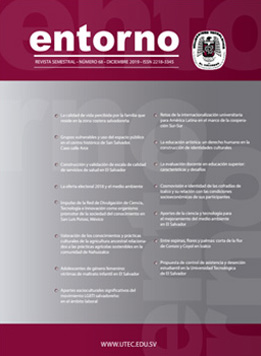The creation and validation of a scale to measure the quality of health services in El Salvador
Published 2019-12-30
Keywords
- Health indicators – El Salvador – measurements,
- Health services – El Salvador – measurements,
- Medical centers – El Salvador – measurements
Copyright (c) 2019 Entorno

This work is licensed under a Creative Commons Attribution-NonCommercial-ShareAlike 4.0 International License.
How to Cite
Abstract
The objective of this study is the creation and validation of a measuring scale for the quality of health services in El Salvador. It is an instrumental study with a retrospective design. The technique used for data collection was the survey. For this purpose, a non-probabilistic sample of 463 people from both sexes was taken. The average age of the sample population is 35.73 years old. The median for men was 34.73 years old, and for women 36.23 years old. In relation to sex, 297 (64,3 %) are women and 165 (35,7 %) men. The results show that the test has adequate content validity, construct validity and reliability.
Keywords: Health indicators – El Salvador – measurements. Health services – El Salvador – measurements. Medical centers – El Salvador – measurements.
DOI: https://doi.org/10.5377/entorno.v0i68.8445
URI: http://hdl.handle.net/11298/1125
References
- Carretero-Dios, H. & Pérez, C. (september, 2007). Standards for the development and review of instrumental studies: Considerations about test selection in psychological research. International Journal of Clinical and Health Psychology, 7(3), 863-882.
- Donabedian, A. (july, 1966). Evaluating the quality of medical care. Milbank Memorial Fund Quarterly, 44(3), 166-203.
- Donabedian, A. (november, 1974). Concepts of health care quality: A perspective. Washington, D. C., United States: National Academy of Sciences, Institute of Medicine. Donabedian, A. (marzo-abril, 1988). Veinte años de investigación en torno a la calidad de la atención médica, 1964-1984.Salud Pública Méx, 30(2), 202-215.
- Donabedian, A. (may-june, 1984). Quality, cost, and cost containment. Nurs Outlook, 32(3), 142-145.
- Gronlund, N. E. (1976). Elaboración de tests de aprovechamiento. México, D. F., México: Trillas.
- Miller Franco, L., Silimperi, D. R., Veldhuyzen van Zanten, T., MacAulay, C., Askov, K., Bouchet, B.,... Márquez, L. (2004). Sostenibilidad de la calidad en la atención de salud: Institucionalización de la garantía de la calidad. Recuperado de https://www.usaidassist.org/sites/default/files/sostenibilidad_de_la_calidad_de_la_atencion_de_salud_2004.pdf
- Ministerio de Salud. (2017). Dimensiones de la calidad de atención de los centros de salud. San Salvador, El Salvador.
- Mira, J. J. y Aranaz, J. (2000). La satisfacción del paciente como una medida de resultado de la atención sanitaria. Medicina Clínica, 114(3), 26-33.
- Montero, I. & León, O. G. (2007). A guide for naming research studies in psychology. International Journal of Clinical and Health Psychology, 7(3), 847-862.
- Nunnally, J. C. y Bernstein, I. H. (1995). Teoría psicométrica. Madrid, España: McGraw-Hill.
- Oliver, J. G. (julio-agosto, 2005). Calidad en salud pública. Gac Sanit, 19(4), 325-32.
- Organización Panamericana de la Salud y Organización Mundial de la Salud. (2007). Política y estrategia regional para la garantía de la calidad de la atención sanitaria, incluyendo la seguridad del paciente [Conferencia]. Recuperado de http://iris.paho.org/xmlui/bitstream/handle/123456789/3760/csp27.r10-s.pdf?sequence=2&isAllowed=y
- Schneider, H. y Palmer, N. (2002). Getting to the truth? Researching user views of primary health care. Health Policy Plan, 17(1), 32-41.
